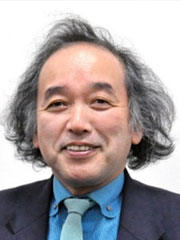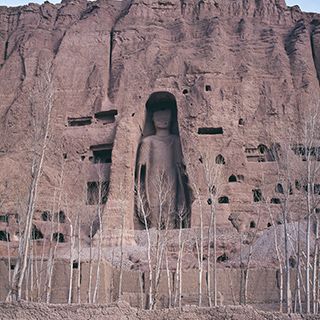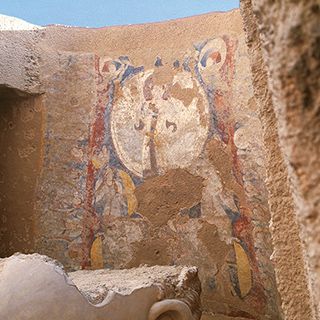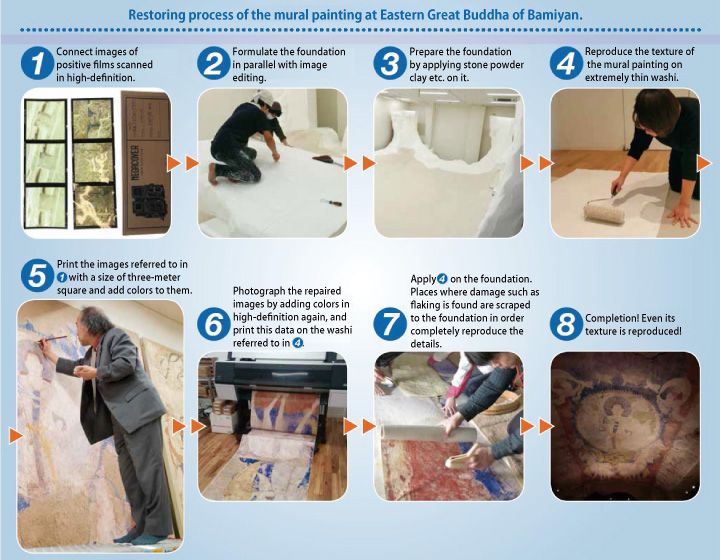Research Results
Innovations through art and science and technology
Cultural assets about to be lost rescued by Clone Cultural PropertiesFY2021 update

- Miyasako Masaki (Professor Emeritus / Project Professor of Tokyo University of the Arts)
- Center of Innovation (COI) program (2013-2021)
- “Creating Innovation for 'Synesensory' through Inspirational Art and Science & Technology”
Research Producer of “cultural sharing” group
Bringing the ceiling mural painting at Eastern Great Buddha of Bamiyan back to life
Cultural assets sometimes crumble to nothing or disappear all of a sudden. They can be damaged not only in accidents such as a fire but also by man-caused actions. Once lost, it is extremely difficult to return a cultural asset that to its original state.
In Afghanistan, which flourished as a crossroad of the Eastern and Western civilizations, valuable cultural heritages have been destroyed and plundered one after another in the long-lasting war. In March 2001, at Bamiyan in the central part of Afghanistan, the two great Buddhas, Eastern Buddha and Western Buddha, were blown up and disappeared without a trace.
The Center of Innovation (COI) program is a research funding program that promotes challenging and high-risk R&D to realize our visions for our ideal society. Through the combination of the latest science and technology and the restoration technologies uniquely developed by Tokyo University of the Arts, the ceiling mural painting that was lost with the Great Buddha was successfully brought back to life by Professor Miyasako Masaaki (at that time), the then research leader.
Restoring the "DNAs of arts" as Clone Cultural Properties
Tokyo University of the Arts boasts the world's leading technology and capability for the reproduction of paintings. Combining the latest photography technology and two-/three-dimensional printing technologies with the reproduction technology led to the creation of patented technology that is able to reproduce cultural properties with a high degree of accuracy and the same texture. Reproductions produced with this new technology are, when looked at from a physical viewpoint, highly accurate to the point of realizing the same material feeling and texture. Furthermore, in those works, even the "DNAs of arts" including techniques, materials, cultural backgrounds were restored to their original states. Therefore, they were named "Clone Cultural Properties." This technology is best characterized by its capability to restore even art objects that have already been lost due to flowing out, breakage, disappearance, etc.
Professor Miyasako was determined to challenge what was considered to be impossible, that is, restoring the ceiling mural painting at Eastern Great Buddha of Bamiyan that had been completely destroyed. It was because he thought that reproducing cultural assets around the world that had flowed out or disappeared, not only in terms of their "physical existence" but also their spiritual natures and purposes, would make it possible to undo the damage brought upon those cultural assets and to realize the sharing of cultures.

Eastern Great Buddha of Bamiyan before its destruction
[photo credit: JSTnews]
Ceiling mural painting prior to its destruction
[photo credit: JSTnews]
Integration of digital technology and manual preservation and restoration technology
The ceiling mural painting to be restored by using the patented mural painting replicating technology was painted on an arch-like rock exceeding seven meters in length and six meter in width. As basic data, a huge number of photographs, nearly 15,000, taken by the Kyoto University Central Asia Academic Research Team in the 1970's were used. First, out of those photos, Professor Miyasako and his fellow researchers selected about 150 color photographs with the ceiling mural painting in them. For the restoration of places where the resolution was not high enough, they decided to put together division photographs taken from the closeup of the mural painting; however, since it was painted on the arch-like rock, it was impossible to reproduce the painting simply by connecting the plane photographs. With that, based on the three-dimensional data that a German research team obtained in the measurement of the rock at the Great Buddha after the explosion, a development diagram of mural painting was formulated by correcting the distortions in the photographs.
Next, the development diagram was printed at a reduction ratio of 60%, and the colors of those prints were corrected by hand drawing while referring to the color photographs and fragments of the mural painting. For the areas in which major flaking had taken place and the areas for which clear photographs were not available, on the basis of the past documentary records, restoration work was conducted to an assumable degree. On the basis of the finally completed digital data of the development diagram for the mural painting, the production of a mural painting almost in full-scale was launched. After the foundation of the mural painting on the rock was made by using a light material, even the subtle unevenness of the rock wall surface was precisely reproduced in reference to the three-dimensional data from the German research team, and then stone powder clay was applied on the rock surface to adjust its texture. The stone powder clay was also applied on pieces of washi Japanese paper, on which the mural painting would be printed in a thin layer, and after restored images were printed on those pieces of washi with an ink-jet printing method, they were pasted on the foundation. After that, coloring work was performed manually by making full use of technologies for the preservation and restoration of Japanese-style and Western-style paintings.
In April 2016, at the exhibition held at Chinretsukan Gallery of the University Art Museum, Tokyo University of the Arts, delegates representing the Afghan government who were visiting were very delighted to see the restored mural painting as Clone Cultural Properties, and said: "Here is the very place we can call our home country."
Also, in May 2016, the mural painting was exhibited at the side event of the G7 2016 Ise-Shima Summit (Summit of the Major Industrialized Nations); thus, this painting had a share in demonstrating Japan's highly advanced technology in restoring cultural assets, in addition to conveying the message that it is possible to protect cultural assets from terrorists.

Restoring "Sun God Soaring in the Sky" mural painting at Eastern Great Buddha of Bamiyan to the state before its destruction (2016)
[photo credit: JSTnews]
Bringing about innovations through art and science and technology
The COI site, Tokyo University of the Arts has worked on the restoration of the mural painting of Horyuji Temple that was damaged by a fire in 1949 as well as on the ceiling mural painting at Eastern Great Buddha of Bamiyan. After integrating a lot of materials including dry glass plates photographed before the fire damage, collotypes, reproductions made by painters, etc. using digital technology, the mural painting was successfully restored to its state prior the fire damage in full-scale by utilizing the patented mural painting replicating technology.
Tokyo University of the Arts, “Creating Innovation for 'Synesensory' through Inspirational Art and Science & Technology” COI site
In addition to the production of "Clone Cultural Properties," with the aim of bringing about innovations through art and science and technology, the COI site, Tokyo University of the Arts is working on various subjects such as research on synesthetic media, research on robotic performance arts, research on inclusive arts, designing music & science, as well as cultural diplomacy and art business, with emphasis on innovations "to nurture culture," "to nurture the mind" and "to nurture the bonds."
